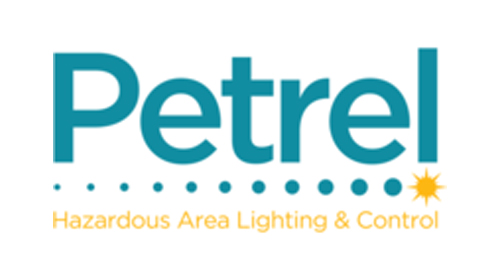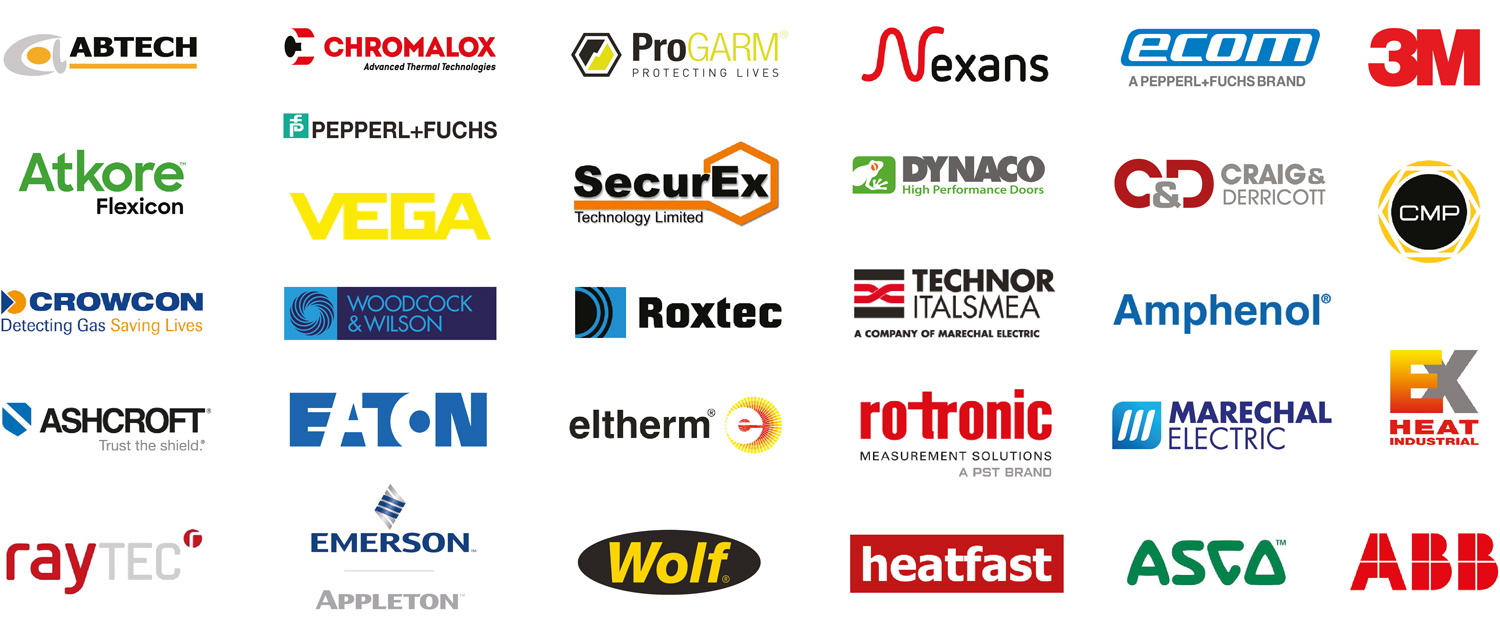Use of LED Light Fittings for Hazardous Area Lighting | Petrel Whitepaper
Published 16 Jul 2019
-
uploaded by Chris Dodds - Sales & Marketing Manager Thorne & Derrick
Hazardous Area Lighting
LED Light Fittings
Overview
The purpose of this White Paper is to discuss in layman terms the use of Petrel LED light fittings within hazardous areas. The intention is to de-mystify the selection of LED light fittings and luminaires by explaining the benefits and pitfalls in non-technical terms, and offer basic advice on issues which are specific to lighting for explosive atmospheres, whilst also providing an insight into the kind of service you should expect from your supplier of light fittings for Zone 1 & Zone 2 lighting installations in hazardous areas.

Hazardous Area Lighting For Potentially Explosive Atmospheres In Both Onshore & Offshore
Atex Directive
ATEX is a European directive covering equipment intended for use in potentially explosive atmospheres.
Within the European Community, manufacturers of such equipment, including lighting product ranges, must comply with the requirements of this ATEX directive by law, and maintain relevant certificates to demonstrate conformity.
Certain other countries accept the IECEx standard, which is derived from similar principles.
In addition to the technical requirements demanded by the appropriate standards for each explosion protection concept, the ATEX directive imposes additional demands on certificate holders in terms of quality assurance system, product documentation, installation information, possible limitations of use in relation to its intended environment, labelling information etc.
Categories and Zone definitions
for gas and dust
The information below is a guide only.
Under the strict guidelines issued by the HSE, employers must classify areas where hazardous explosive atmospheres may occur into zones. The classification given to a particular zone, and its size and location, depends on the likelihood of an explosive atmosphere occurring and its persistence if it does.
Luminaire manufacturers of lighting fittings for hazardous areas can only offer advice on the luminaire type and not the definition of the zone in which it is to be used.
Lighting for Gas Explosive Atmospheres & Zones
Zone 0: A place in which an explosive atmosphere consisting of a mixture with air of dangerous substances in the form of gas vapour or mist is present continuously or for long periods frequently.
Zone 1: A place in which an explosive atmosphere consisting of a mixture with air of dangerous substances in the form of gas vapour or mist is likely to occur in normal operation occasionally.
Zone 2: A place in which an explosive atmosphere consisting of a mixture with air of dangerous substances in the form of gas vapour or mist is not likely to occur in normal operation but if it does occur, will persist for a short period only.
Lighting for Dust Explosive Atmospheres & Zones
Zone 20: A place in which an explosive atmosphere in the form of a cloud of combustible dust in air is present continuously or for long periods frequently.
Zone 21: A place in which an explosive atmosphere in the form of a cloud of combustible dust in air is likely to occur in normal operation occasionally.
Zone 22: A place in which an explosive atmosphere in the form of a cloud of combustible dust in air is not likely to occur in normal operation but if it does occur, will persist for a short period only.

Zone 1 Hazardous Area Lighting – Petrel Bulkhead, Fluorescent Fitting, Well Glass, Floodlights & LED Luminaires (ATEX Certified)
Why LED Lighting?
Background to Lighting for Hazardous Area Industry
LED luminaires or light fittings as we know them are a very recent addition to the general lighting market.
The LED or Light Emitting Diode was introduced on an industrial scale in the 1960s, at the time its main usage was for indication lamps within electrical and electronic devices.
By the 1990s the LED had been widely adopted in moving message (sign) displays, modern electronic devices such as mobile phones, computers etc. It would not be until around 2006 when research and development had advanced the LED to the point of it being a useful general light source.

Zone 1 LED Luminaire ATEX – Petrel 7 Series
LED Lighting Efficiency
The development of the LED as a general light source has since accelerated at such a pace that they are now in some cases producing 200 Lumens per Watt. Until very recently the theoretical maximum output had been calculated to be around 220 Lumens per Watt.
To put the above into perspective a GLS lamp typically produces around 10 Lumens per Watt, a Fluorescent lamp typically produces around 90 Lumens per Watt and an HID (High Intensity Discharge) Lamp produces up to 120 Lumens per Watt.
As you can conclude from the above the potential for energy savings has been the main driving force behind the development of ever more efficient LED lighting solutions.

Zone 2 Hazardous Area Lighting – Petrel LED Luminaire, Fluorescent Luminaire, Floodlights & Bulkheads (ATEX Certified)
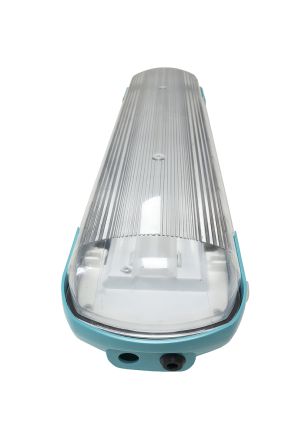
ATEX Light Fitting | LED
Luminaire Lumens versus Lamp Lumens
One of the most confusing aspects of luminaire selection for hazardous area lighting is that some manufacturers will quote luminaire lumens and others will quote just lumens or lamp lumens. Luminaire lumens are a measured figure of the light produced by the luminaire once the Led is installed inside.
This takes into account efficiency losses through the diffuser of the luminaire and any other aspect of the luminaire design which may affect its efficiency. Lumens or Lamp lumens are light outputs taken directly at the led source and do not include any losses or inefficiencies of the luminaire.
The above is particularly relevant in hazardous area lighting due to the protection concepts employed by manufacturers to achieve a “zone certified” product.
Pictured: 71W LED Module Hazardous Area Light Fitting Zone 1 – T Class T4, 240V
Many manufacturers use an encapsulation or lensing arrangement to achieve the standards. These protection concepts introduce further materials which can reduce light output.
With the above in mind it is vital to check with the manufacturer if the figures quoted are true luminaire lumen figures backed up with photometric test data.
This will provide assurance of a genuine like for like comparison when making specification decisions. Always ask for a specific lighting design or proof of lumen output claims from the manufacturer. We will cover the importance of lighting design later in this document.
Pictured: 150W Hazardous Area Floodlight LED Zone 2 – Temp T4, 220V 240V
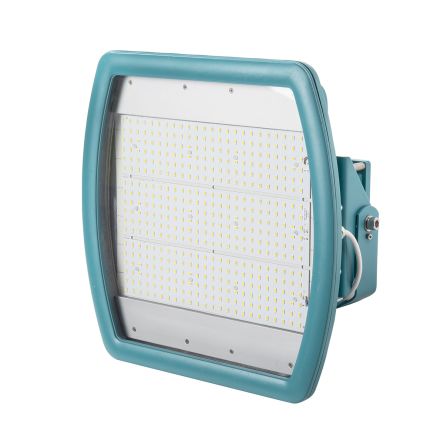
ATEX Floodlight | LED
Long Service Life
Another plus point for the LED is its very long service life of typically 30,000 to 100,000+ hours of operation. This extended service life is particularly relevant within the hazardous area environment, where maintenance of lighting is both dangerous and extremely costly.
Maintaining traditional light sources within hazardous areas can mean having to shut down site operations to allow any lamp changes to be made. For this reason many sites do not perform lamp maintenance until absolutely necessary, usually when safety is being affected by the lack of working lighting within an area. The costs involved can be significant due to having to stop site production.
Light Colour & CRI (Colour Rendering Index)
Light emitted by a LED is made up of wavelengths with a specific colour depending on the semiconductor material. One of the most common ways to produce white light is to utilise the property of photoluminescence.
In this approach an LED which produces blue light is covered with a thin layer of phosphor. When the LED is turned on the blue wavelength passing through the phosphor produces white light. The colour temperature in Kelvins is controlled by the mix of phosphor used.
Typically the warmer the white light the less efficient is the conversion from blue to white.
Typical colour temperatures are:
- 2700K – 3200K WW Warm White Light
- 4000K – 4500K NW Natural White Light
- 5000K – 5500K DW Day White Light
The CRI (Colour Rendering Index) is a measure of how accurately a light source renders colour. The better the light source represents colours, the better the index. Sunlight and GLS give a CRI 100, this would be described as true colour rendering.
They have a wide spectrum which replicates all colours well. The CRI of a LED varies between 70 and 97, a fluorescent lamp is between 60 and 98, and a High Pressure sodium can have a CRI as low as 60.
Interestingly one of the most common light sources still in use today in the external lighting field, the SOX or low pressure sodium lamp has a CRI of 0! This in effect means that no colour is represented accurately under this type of lighting.
In hazardous area lighting certain protection concepts can have an effect on both colour temperature and CRI. The encapsulation of the LED light source within a hazardous area luminaire can make the colour temperature cooler.
For instance a colour 4000K LED will have a tested colour temperature of around 7000K when encapsulated. This is the result of removing the air gap in front of the phosphor. However the CRI can improve once the LED is encapsulated. In the above example the CRI improved from 85 to 90, which means even though the colour temperature is cooler the Colour rendition will still be excellent.
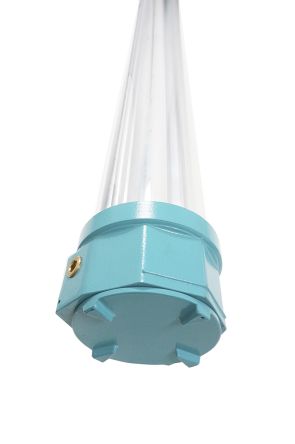
ATEX Light Fitting | LED
Suppliers of LED Lighting
Service You Should Expect From A Manufacturer
Quality Assurance
The hazardous area equipment manufacturing market is one of the most highly regulated sectors within manufacturing. All manufacturers should be able to supply their customers with relevant certification for any products which they supply into a hazardous environment.
If the luminaire manufacturer is from overseas then you should request an English language version of their test certification. Check for yourself that the test house and notifying body on the test certificates are correct.
In hazardous area lighting, the manufacturer should also be able to supply photometric test data for the products they manufacture.
Those with an in house design capability will also be able to supply and carry out lighting designs to the customers brief.
Pictured: 56.8W LED Module Hazardous Area Light Fitting – Zone 1 LED T Class T6 230V
Hazardous Area Lighting Design
One of the most important aspects of any lighting system is its initial design. This is even more important in hazardous areas due to the often complicated nature of both new and existing installations.
Many manufacturers can supply a lighting design which is for an office or open area warehouse etc., but hazardous area design is very different. There are very few if any sites which do not have multiple obstacles which can impede the effectiveness of the lighting.
A typical example would be a chemical site which will have various walkways pipe runs tanks etc. within one area.
To produce an open area design for this kind of environment would be at best inaccurate and at worst not fit for purpose.
The advent of modern design software allows manufacturers to produce lighting designs which can show, in 3D, the space to be lit and give a more accurate representation of what the end user needs for a given space. See sample designs below.
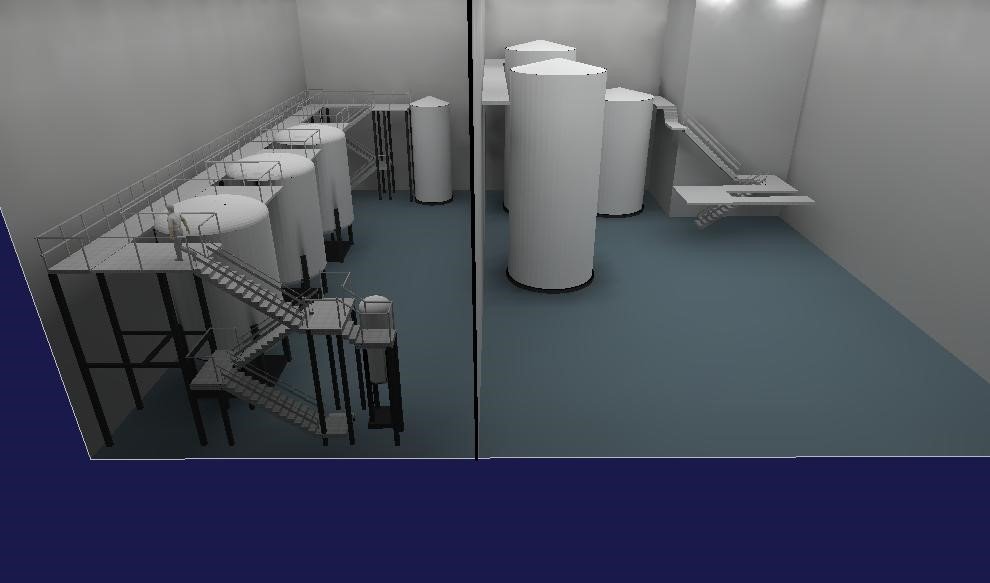
Fig.1 Sample Gantry Walkway 3D
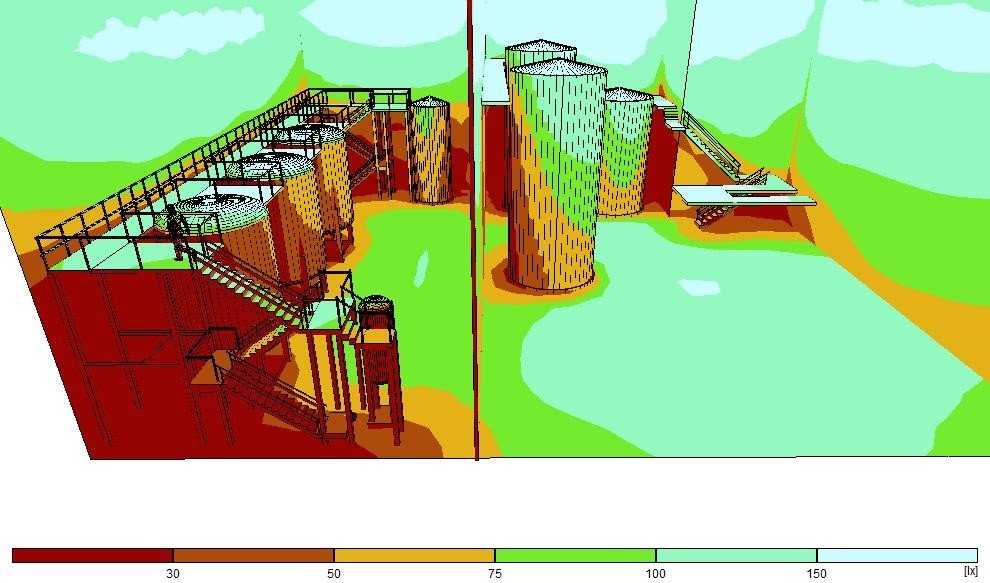
Fig.2 Sample Gantry Walkway light levels
These designs can be done remotely using information provided by the end user, but are more effective when accompanied by a site survey if this is an existing upgrade.
Traceability of Lighting Products
A manufacturer of hazardous area lighting products should be able to provide traceability on all its products and parts used within its lighting range. It is vitally important that your chosen manufacturer has full visibility on its supply chain and manufacturing partners.
Due to the nature of the manufacturing and approvals process manufacturers must know in advance of material changes which may affect their current product certification.
Each luminaire should have an individual serial number to allow its manufacture to be traced to a specific point in time and method of manufacture.
LED Lighting Product Warranty
Product warranty is becoming both a major selling tool and also a major bone of contention, not only in the Hazardous area sector but in the LED lighting market in general. There are suppliers in the market place offering 10 or even 15 year warranties on their products without knowing where or how they are being installed.
Some of these suppliers have been in existence for less than this time so it is extremely difficult for end users be confident in these warranty offerings. In fact, there can be no guarantee. A reputable supplier or manufacturer will always stand by their product, but before offering any extended warranty will want to know where and how the products are to be installed.
This is extremely relevant in hazardous area installations as by their very nature the installations are far more gruelling on the luminaires than a standard office, domestic or even industrial environment.
Reputation & History of Lighting Supplier
Finally an aspect of your supplier that is probably the most important element, Trust. If you are considering a manufacturer and supplier, how much do you know about them? How long have they been established? Are they reputable company? Does the company have in house design facilities, are they manufacturers or do they factor imported lighting products? Can you visit their site and see their lighting products being produced?
A good manufacturer will be more than happy for potential customers to visit their site, and they will give you details of reference projects. Also it should be possible to talk to other customers who have had dealings with them to get first hand opinions of their experience.

T&D UK & Exports support worldwide oil, gas and petrochemical projects with an extensive range of Hazardous Area Lighting, Motor Starters & Electrical Enclosures.
ELECTRICAL & PROCESS INSTRUMENTATION EQUIPMENT
FOR EXPLOSIVE ATMOSPHERES
Thorne & Derrick are Specialist Distributors of Hazardous Area & Explosion Proof Equipment with IECEx & ATEX Certifications to the onshore and offshore oil, gas, petrochemicals and process industries.
Key Product Categories: Control Panels | Plugs & Sockets | Isolators | Enclosures & Junction Boxes | Lighting | Control Stations | Motor Starters | Heat Trace Cables & Systems | Gas Detection & Detectors | Fire Detection & Detectors | Heat Detectors | Electrical Heating & Heaters


Trace Heating | System Design & Supply
Further Reading
- Appleton Rigmaster | The Hazardous Area LED Linear Light Fitting
- Prevent Ignition In Hazardous Areas With Appleton EFD/EFDB & EDS Control Stations & Pilot Lights
- Appleton Areamaster Zone 1 LED Floodlight for Hazardous Area Lighting (Video)
- Hazardous Area Lighting | Upgrading Fluorescent To LED Light Fittings With ATEX Certification
- Explosion Proof Lighting for Hazardous Areas | Walkway Lighting

